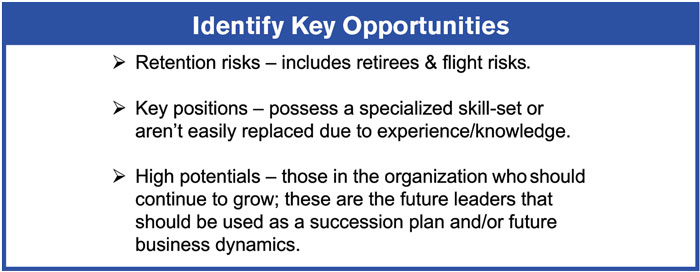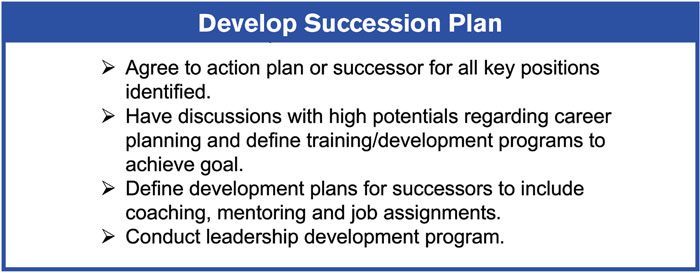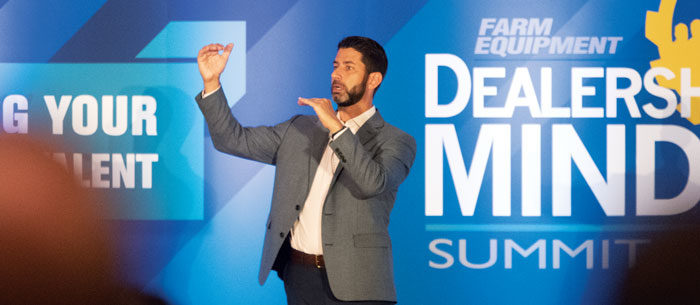For Josh Waggener, a deep bench is more than just a crucial strategic element of game play for sports teams striving for a winning record. It’s also a vital component of success for dealerships that are looking to grow and expand their impact.
“If you want to grow your footprint seamlessly, you’ve got to become an expert at succession management,” says Waggener, president and CEO at Hutson Inc., a 29-store John Deere equipment dealer headquartered in western Kentucky. “If you want to increase your retention rate, grow your bottom line, be an employer of choice [and] be a force to be reckoned with, you’ve got to do it with an infinite-minded bench. It’s the only way.”
Waggener defines a finite-minded bench as one comprised of employees who emphasize business results and annual metrics. He says an infinite-minded bench is more attuned to employee engagement and empowerment.
“If you’re only worried about your direct personnel expenses for this year and your budget and your bonus for this year, you’re doing it wrong,” Waggener says.
Before any company can fully embrace an infinite bench mindset, Waggener says they need to identify their primary goal. For Hutson, that goal is to be one of the largest total ownership groups (TOG) in North America. Once the primary goal has been identified, he says companies can begin working toward building an infinite bench.
Dealer Takeaways
- An infinite-minded bench values employees and measures engagement alongside financials.
- Expand your lens beyond immediate vacancies, and look to train potential leaders for future needs and opportunities.
- Maintain open lines of communication, and make sure all members of your organization understand the company’s goals and vision.
- Focus on the whole person when working with employees and support them in maintaining a strong work-life balance.
“If you’re summarizing your planning process, you’ve got to get it down to your high-risk positions,” Waggener says. “That means in the next year, who is not going to be here? You’ve got to think [about] who is leaving. Then you have those open, candid conversations.”
Once any impending vacancies have been addressed, Waggener moves on to positions of moderate risk. He identifies those as roles held by employees who are likely going to leave the company in the next 2-4 years. Waggener says he’s built a workplace environment in which employees feel safe sharing their potential future plans, whether those plans are set in stone or liquid in nature.
“They’re comfortable having that conversation because they don’t worry that we might terminate them or be vengeful,” he says. “They’re comfortable because they know that we want them there as long as they want to be there, so they’ll have that open conversation with us.”
Allocate Time, Resources to Training Potential Leaders
However, Waggener says planning for and creating an infinite bench doesn’t just look like training people to take over for already existing roles.
“Here’s our shift — instead of focusing on succession planning for only current roles, we set expectations for our future leaders,” Waggener says. “We knew what we wanted to look like when we grew. Instead of waiting until it happened, we said, ‘Well, if we do this, we’re going to need this role, this role, this role and this role. Let’s go ahead and start preparing for those instead of what we already have.’”

Although Waggener pays careful attention to potential vacancies and upcoming retirements, he places equal importance on identifying and cultivating those employees with a high potential for future leadership roles.
“High potentials are the most important to me, if I’m putting them in order,” he says. “These are those in an organization that should continue to grow into future leaders. We know who they are. We have them identified pretty quickly.”
Deep Bench Helped Facilitate Expansion
That focus on forward planning was instrumental in helping Waggener and his team prepare to shepherd their employees through one of the company’s biggest changes to date.
Hutson recently expanded tremendously, acquiring 2 dealerships with a combined 18 locations in 2021. Not only did their workforce double, but the move increased the company’s revenue by 50% — a change Waggener believes wouldn’t have been possible without having invested the time and energy in developing a corps of employees who were trained and prepared to take over new and existing leadership positions throughout the company.
“With a finite mindset, you can’t do what we did in the timeframe that we did it in,” he says. Hutson closed the purchase deal in 60 days. “We went from 12 locations to 30 locations and from 3 states to 4, and from $500 million in revenue to $750 million. Eighteen locations, 3 sets of management, 3 sets of business systems, 3 sets of culture expectations. Good thing we had built an integration playbook down to who is going to lock the door when they leave. We knew what we were doing when we went.
“But the only reason we were able to do this was because we had worked tirelessly to build our bench.”
To facilitate the company’s expansion, Waggener asked 3 key employees to relocate to Michigan to lead the transition taking place at the newly acquired stores.
He says those employees understood the importance of communicating Hutson’s corporate culture and expectations to the new team members, and Waggener says their willingness to uproot and move to a new state is a credit to their infinite bench mindset.
“If you want to increase your retention rate, grow your bottom line, be an employer of choice [and] be a force to be reckoned with, you’ve got to do it with an infinite-minded bench…”
“The cool thing is as soon as they left, we had another group that just slid right in behind them because we were planning, planning, planning,” Waggener says. “If you’re going to buy 18 dealerships, you better start building your team now. If you don’t, it’s really hard to be successful. I’m not saying you can’t do it, but if we didn’t have our bench where it was when we bought these Michigan stores and we didn’t have people that would go up there and take the Hutson culture with them, we’d be scrambling right now.”
Not only was Waggener able to send a team to Michigan to seamlessly implement a regional structure that had worked for them in the past, but he didn’t have to expend time and energy searching for qualified leaders to fill unexpected vacancies. That meant he and his colleagues were able to focus their efforts on quickly restructuring one of the dealerships they’d purchased — a dealership that was quickly losing money.
“One of the dealerships we bought was bleeding money — millions,” Waggener says. “But after we combined them and put some of our teams together and came up with a regional structure, it took us 1 month to make money up there. That quick, 1 month. Because we made a commitment to the team.”
Part with Employees Who Don’t Embrace Company Goals
Part of making a commitment to his employees means also being willing to take the sometimes difficult step of removing employees who are more focused on themselves than the company’s goals. Waggener recalls when, 4 years ago, he told his team something that may provoke a few raised eyebrows.
“I stood in front of my team and told them, ‘It is not about you. It’s not about you and if you make it about you, you won’t work here,’” Waggener says. “I had some people that I fired. We didn’t fire them for no reason — we coach and build and mentor. [We ask ourselves], is this problem a management issue or is it an employee issue? Once we got through there, if you still thought wrong and made it about you, you didn’t get to work with our team anymore.”
Waggener says that kind of decision making and priority setting is possible because he’s worked hard to cultivate up-and-coming employees and train them for success. However, while he believes in the necessity of cultivating a deep bench and training for succession, Waggener also notes the importance of developing a people strategy that aligns with the business strategy in place.

“As you’re growing this infinite-minded bench and putting your strategy in place, what are you doing for all your existing employees?” he says. “Are you setting annual goals? Are you setting quarterly goals? Are you doing those things that tie into what your business goals are?
“Because if your people don’t understand what your business goals are, how are they supposed to know what they are supposed to show up and do every day? How do they tie into the greater cause of the greater good?”
Foster Loyalty by Supporting Work-Life Balance
Not only should senior leaders be directly and actively engaging with all employees, Waggener says, they should also be seeking out opportunities to coach and mentor employees so they can learn to lead from the trenches of the organization.
“Training and education are a big part of what we do, but guess where the real knowledge comes from? It’s in the trenches,” Waggener says. “Your bench strength is important. You’ve got to build a strong infinite bench. But just as important is your existing people in your existing roles who need to feel like they’re also something or part of something bigger.”
Part of supporting those existing people, Waggener says, is creating a corporate climate in which a strong and healthy boundary between work and home is not only acceptable, but is encouraged.
“What I’ve learned is to be more patient and more graceful and to extend an olive branch when necessary,” he says. “If you want to keep people, specifically the millennials who have low tolerance and low patience for us aging folks, you need to drive home the fact that it’s OK to go home at 5 p.m. It’s OK to take the weekend off, it’s OK to have a family. If you need to come in at 11 a.m. tomorrow because your child has a doctor’s appointment, that’s OK. If you need to work from the dealership while your car is getting serviced, I don’t care. You need to be home today? You had a bad night because life happens, you just need to be at home? That’s fine, be at home.”
Waggener says it may sound cheesy, but by just remembering to love the people who work for him, he fosters an environment with employees who are loyal and dedicated to the company.
“Make it about the people,” he says. “You can’t go wrong. If they’re truly feeling built up, loved, empowered and part of bigger purpose than clocking in and clocking out and going home, you’ve got a loyal person for life. It’s not about you. It’s really not.”






